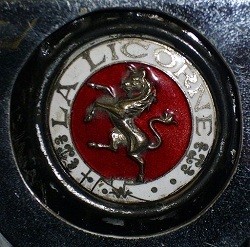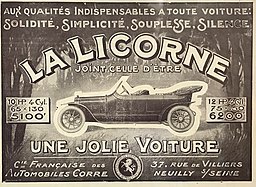La Licorne – A True Unicorn Car
Usually, the term ”unicorn car” is used about a car that is very rare and seldom seen, though well known by automobile enthusiasts. But there also has been a car branded ”The Unicorn” (La Licorne), and now we shall take a look into the history of this almost forgotten automobile manufacturer and find out why and how it became associated with the mythical one-horned creature.
In the Beginning, There Was No Unicorn
It was year 1901 when Jean-Marie Corre, a French cyclist and bicycle manufacturer based in Levallois-Perret, established Société française des Automobiles Corre to begin production of cars. The first products were a tricycle and a four-wheeled cabriolet with a single-cylinder engine. They were marketed under the brand name Corre. Sales were slow, and to boost them the company decided to participate in competition.
It was a wise decision: Corre automobiles proved to be extremely competitive, and racing victories by driver Waldemar Lestienne brought new prominence to the brand. The demand for Corre automobiles increased, and soon they rivalled well-established manufacturers such as Renault and Peugeot.
The Unicorn Takes over
Despite the success in both competition and the market, the young company was in serious financial trouble. Renault had sued Corre for copying their designs, and Corre lost the case. It was the final blow: Jean-Marie Corre was ruined and forced to sell the company in 1907.
The buyer was Firmin Lestienne, race driver Waldemar`s father, who was a successful businessman. The Lestienne family was old and had their own crest, which featured… can you guess? Yes, a prancing unicorn. The cars manufactured by the company now became branded Corre La Licorne, and the unicorn was made the official emblem. Some later models even had a unicorn mascot adorning the radiator cap, and images of unicorns were heavily used in advertising.
The Golden Age and More Racing Victories
Before World War I the company, now based in Neuilly, had grown and it`s range had broadened substantially. After the war the success continued, and Corre La Licorne began to offer commercial models and even small buses. The cars with the unicorn emblem were valued in both country and the city: Farmers and small business owners liked the fact that they were mechanically robust and easy to maintain. Reliability and good fuel economy appealed to urban dwellers, too.
Besides being reliable and not too thirsty, these true unicorn cars were also known for their speed. They took several first places in important races in the period of 1908 – 1932, including the prestigious Monte Carlo Rally in 1930. Waldemar Lestienne was the head of the racing department, and the victories in rallies, race tracks and hill climb events were excellent PR for the brand. The advertising posters of the period often show a speeding La Licorne racing car accompanied by a unicorn, prancing or galloping. These advertisements were true works of art, and some of them are even available as reproductions. The originals are extremely rare and valuable.
Triple Trouble for the Unicorn Car
In late 1920s the automobile industry met two huge challenges. The first was the stock market crash of 1929. The French automobile makers had even more difficult time recovering than the ones in Great Britain or Germany, for example. Only in 1938 the volume of automobile production reached the level of the year 1928. La Licorne`s range consisted of small and mid-size cars, and it was especially hard to compete against the market leaders in those segments.
The second was the switch to use of all steel bodies. Wood, fabric and other lighter materials were out, expensive coachbuilt bodies were an option only for the luxury cars, and manufacturers had to invest in steel presses. It was a sheer impossibility to smaller companies such as La Licorne. It was forced to an ever-deepening relationship with Citroen. In the end of the 1930s, La Licorne cars had both Citroen-sourced bodies and Citroen engines. There were some differences to Citroen models, but there was not much of the unicorn spirit left in La Licorne.
And then, of course, began the World War II.
During the WWII La Licorne`s range was limited to only one model: A small electric car. It was also the last car the company would ever produce. After the war the French automobile industry was completely restructured by the government, and there was no room for the once proud, race-winning unicorn car. In 1947 La Licorne presented a prototype of a new model named Licorne Typ 164 LR, but it was never put into production. The company closed it`s doors in 1950.
La Licorne Today
The name of the company is not too well known even among the automobile enthusiasts, but during it`s existence La Licorne manufactured almost 34 000 cars. Many of them have survived, and are exhibited in museums and automobile events. The true unicorn car is not quite as elusive as it`s mythical namesake, then! There are even clubs dedicated to the brand.
So, if you happen to find yourself in a car museum or an event featuring vintage automobiles – keep an eye out for the unicorn!
Share this on:



Hello,
I have seen this car at least once in my life but never knew it was called a La Licorne car, and is definitely a classic. The history is sad there was no room for this racing car after the stock market crash in the 1920s but I’m glad to know it lives on in museums and vintage events.
Thanks for sharing such a classy historical car.
Best Regards,
Audrey
Hi Audrey! It`s a bit sad story really, especially for a car with such an interesting history, but unfortunately many smaller manufacturers had hard time in France both before and after WW2. Luckily there are many La Licorne survivors, you can find them even for sale from time to time.
Thank you for commenting!
Cheers,
Jani